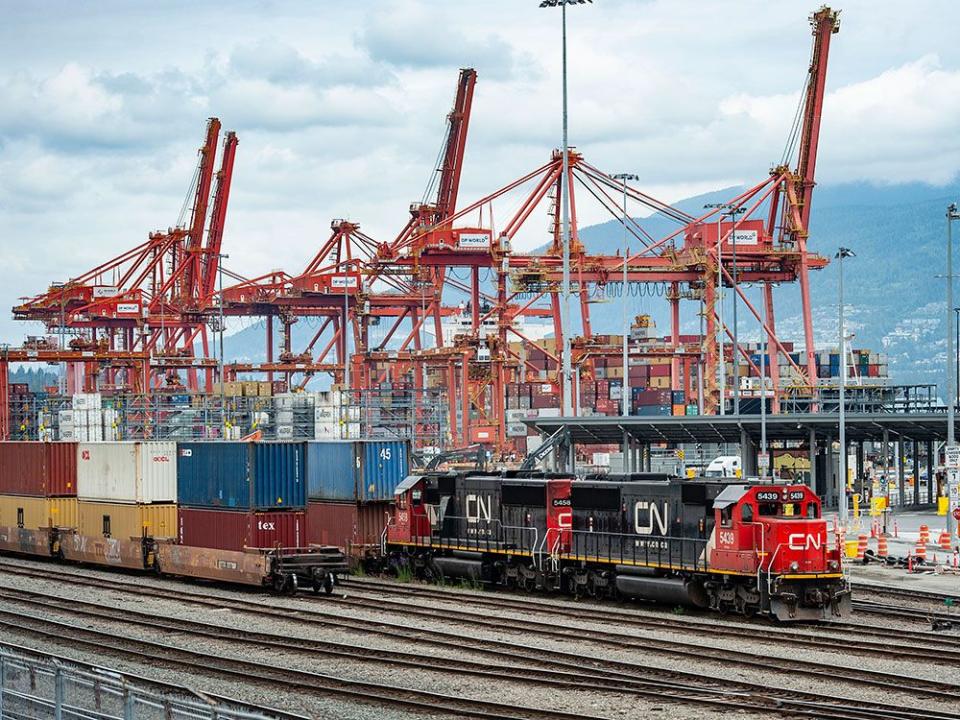Vancouver port bottlenecks ease but cargo still stuck for days

The worst of Canada’s supply chain bottlenecks may be over as port congestion and freight delivery times are starting to improve, according to a Desjardins Economic Studies report, but a full recovery may still have some way to go as freight transportation by rail from the Port of Vancouver continues to experience long delays.
The Vancouver Fraser Port Authority (VFPA) on Monday said two of its four container facilities still had dwell times — the time it takes for containers to be taken away after being unloaded from the ship — of more than seven days. The longer cargo is stuck in port, the more it costs shippers in higher inventory holding costs.
Both Canadian Pacific Railway Ltd. (CP) and Canadian National Railway Co. (CN) reported dwell times of more than seven days at the Centerm terminal in Vancouver, while CN reported the same delay at the FSD terminal.
Ongoing labour issues have also contributed to a lack of drayage capacity at railyards. Fewer available truck drivers to make short hauls from ports or other areas means increased dwell times for imports arriving in Toronto and Montreal. The more delayed containers there are sitting in the yards, the longer it can take to locate and load the correct one.
As a result, eastern Canadian hubs are clogged, which leads to congestion at the Port of Vancouver.
“The Vancouver situation is multifaceted, where one point in the chain is dependent on another and that’s why you’re just seeing this backlog,” Julia Kuzeljevich, spokesperson for Canadian International Freight Forwarders Association (CIFFA), said.
The railways are shifting their freight to other established or even temporary yards to alleviate some of the congestion and create additional storage space for the containers, she said.
CN spokesperson Jonathan Abecassis confirmed that CN has set up temporary additional capacity in both Montreal and Toronto.
“CN’s network is fluid and we have been able to expedite these alternative solutions,” he said in an email.
Kuzeljevich said the CIFAA has joined industry stakeholders to call upon Transport Canada to look at where pressures can be taken off the system.
“We asked if other temporary inland yards, terminals, or another hub such as Winnipeg could take some pressure off?” she said.
More, however, can be done to alleviate the congestion at the Port of Vancouver, she said, as assets and infrastructure are not being upgraded.
Maersk’s struggles to move freight in Canada highlight supply-chain woes
‘Crop yields will suffer’: Fertilizer reduction targets pitting farmers against federal government
The CIFAA is working with the Port of Vancouver to promote the Robert Banks Terminal 2, but Kuzeljevich said that the project is bogged down in environmental approvals.
The City of Delta in February requested the federal government postpone or deny approval of the terminal because of the adverse impact it would have on the surrounding community and environment.
“It just takes too long to market new projects,” Kuzeljevich said.
The federal government in January hosted a National Supply Chain Summit, which brought together business leaders and associations to discuss the challenges facing Canada’s supply chain and to identify potential solutions.
To further advance this work, Minister of Transport Omar Alghabra at the summit announced the creation of the National Supply Chain Task Force.
Transport Canada in March stated that the task force is set to meet with industry stakeholders to develop both short- and long-term actions “to strengthen the efficiency, fluidity and resiliency of transportation infrastructure and reliability of Canada’s supply chain.”
In an email, Transport Canada spokesperson Frédérica Dupuis said the task force’s recommendations are expected to address the “need for congestion reduction in critical infrastructures.”
She said the task force is expected to provide a report on the development of a National Supply Chain Strategy to the Minister of Transport this fall.
• Email: rshelton@postmedia.com | Twitter: robms4
Listen to Down to Business for in-depth discussions and insights into the latest in Canadian business, available wherever you get your podcasts. Check out the latest episode below:

 Yahoo Finance
Yahoo Finance 